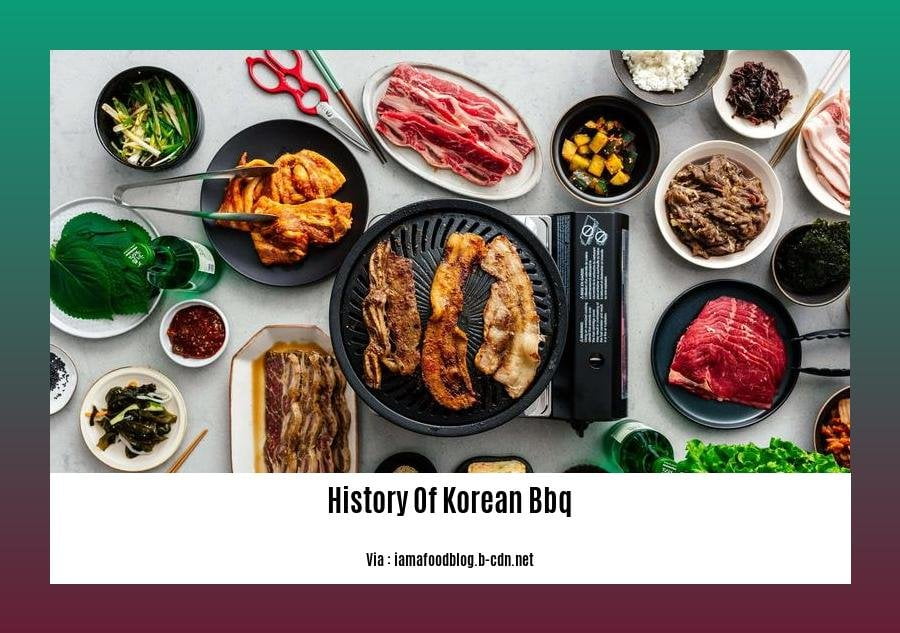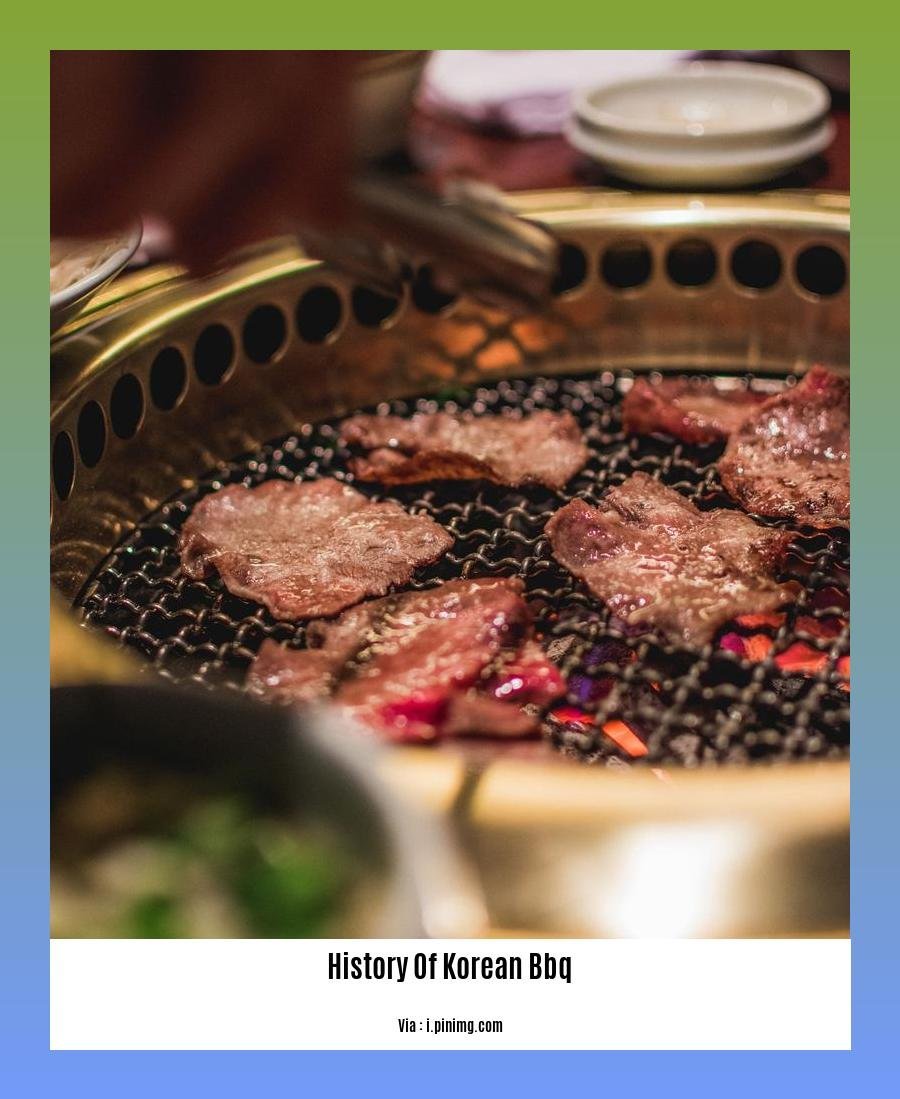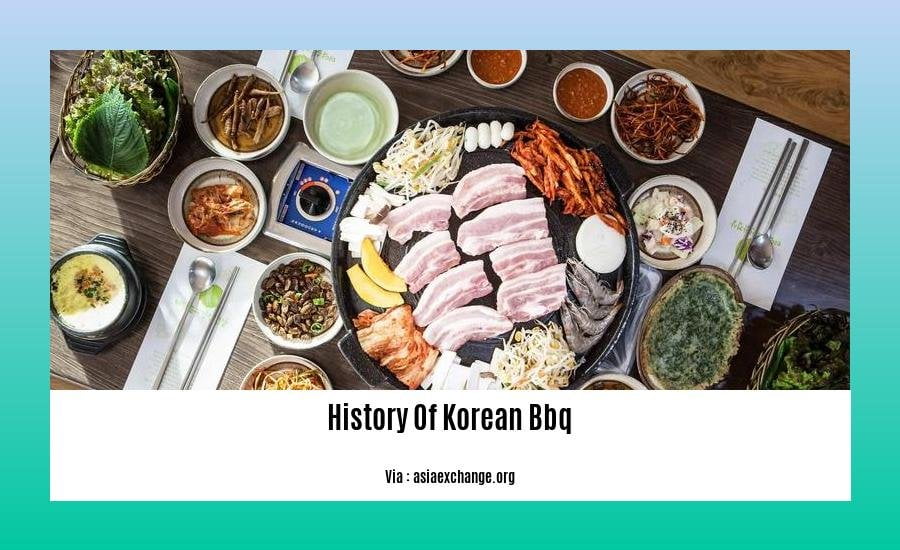Embark on a captivating culinary journey through the history of Korean barbecue in [A Culinary Journey Through the History of Korean BBQ: Tracing its Roots and Global Evolution]. Explore the ancient origins of grilling techniques that laid the foundation for this beloved cuisine, and discover how Korean barbecue has evolved over the centuries to become a global culinary phenomenon. From its humble beginnings to its rise as a symbol of Korean national pride, this article delves into the rich cultural heritage behind every sizzling morsel.
Key Takeaways:
Korean barbecue is a popular Korean method of grilling meat, particularly beef, pork, or chicken.
Bulgogi is the most renowned variety, marinated with soy sauce, sugar, ginger, scallions, sesame oil, pears, garlic, and pepper for tenderness.
Korean barbecue is typically served with a variety of side dishes like rice, kimchi, pajeori, and many others.
The foundation for Korean barbecue was laid during the Goguryeo period (37 BCE-668 CE) when meat was roasted over an open fire with diverse sides.
During the Joseon Dynasty (1392–1910), “neobiani,” or thinly sliced marinated and grilled beef, emerged and gained popularity.
History of Korean BBQ: A Journey Through Time

Korean barbecue, with its smoky aroma and flavors, is a beloved culinary art that has captivated taste buds worldwide. In this blog, we’ll delve into the history of Korean BBQ, tracing its roots back to ancient grilling techniques and exploring its evolution into a global culinary sensation.
The Origins: Embracing Ancient Grilling Techniques
The history of Korean BBQ can be traced back to the Goguryeo period (37 BC-668 AD). During this time, meat was often skewered and roasted over an open fire, a practice likely influenced by nomadic tribes of Central Asia. These early grilling techniques laid the foundation for the Korean barbecue we know today.
The Joseon Dynasty: Neobiani and Royal Feasts
During the Joseon Dynasty (1392-1910), Korean barbecue underwent significant refinement. “Neobiani,” or thin slices of marinated and grilled beef, emerged as a popular dish among the royal court. These thinly sliced meats were often marinated in soy sauce, garlic, and sesame oil, resulting in a tender and flavorful dish.
Modern Korean BBQ: A Culinary Revolution
In the modern era, Korean BBQ has experienced a global resurgence, becoming a beloved cuisine worldwide. This culinary revolution was driven by several factors, including:
Increased Globalization: The rise of globalization has led to a greater appreciation for diverse cuisines, with Korean BBQ gaining popularity in countries like the United States, Australia, and the United Kingdom.
Korean Wave: The Korean Wave, or “Hallyu,” has played a significant role in promoting Korean culture and cuisine on a global scale. Korean dramas, music, and food have gained immense popularity, piquing interest in Korean BBQ among international audiences.
Culinary Innovation: Modern Korean BBQ has embraced culinary innovation, with new marinades, grilling techniques, and side dishes emerging. This experimentation has led to a diverse range of Korean BBQ experiences, catering to the preferences of a global audience.
Today, Korean BBQ stands as a testament to the rich culinary heritage of Korea. Its unique flavors, grilling techniques, and cultural significance have made it a beloved cuisine worldwide. So, the next time you indulge in a sizzling plate of Korean BBQ, take a moment to appreciate the centuries of history and tradition that have shaped this culinary masterpiece.
Craving to know how the umami-packed flavors came to be? Indulge in the fascinating history of Japanese food culture, a culinary journey through the ages that’s sure to whet your appetite.
In the bustling streets of Seoul, a golden delight was born. Dive into the history of Korean fried chicken, a crispy, tantalizing tale that will leave you craving for more.
Regional Variations: Exploring the diverse styles of Korean barbecue across different provinces

Embark on a culinary expedition across Korea, where the sizzling art of Korean barbecue unveils a symphony of flavors and techniques that vary from province to province.
Seoul: A Culinary Melting Pot
– Seoul, a bustling metropolis and the heart of Korean cuisine, presents a delectable array of barbecue options.
– Explore the vibrant streets of Hongdae, where you can savor marinated pork belly, the city’s specialty, grilled to perfection and served with a variety of dipping sauces.
Gyeonggi: The Birthplace of Bulgogi
– Venture to Gyeonggi Province, the birthplace of the renowned bulgogi, a marinated and grilled dish that has become a global favorite.
– Savor the tender slices of marinated beef, cooked on a hot plate or over an open flame, accompanied by an array of banchan (side dishes) and a generous helping of kimchi.
Gangwon: Coastal Delights
– Head to the coastal province of Gangwon, where the freshest seafood takes center stage in the barbecue scene.
– Indulge in grilled octopus, a local delicacy, or savor the succulent flavors of grilled abalone, a prized ingredient in Korean cuisine.
Chungcheong: A Symphony of Flavors
– In Chungcheong Province, the barbecue scene bursts with a diverse range of flavors and ingredients.
– Experience the unique taste of gochujang-marinated chicken, a spicy and flavorful dish that is sure to tantalize your taste buds.
– Don’t miss the opportunity to sample maeuntang, a spicy fish stew, a regional specialty that showcases the province’s love for seafood.
Jeolla: Rustic Charm
– Immerse yourself in the rustic charm of Jeolla Province, where barbecue takes on a more traditional and home-style approach.
– Discover the delights of jeon, a variety of savory pancakes made with fresh vegetables, seafood, or meat, cooked on a hot griddle.
– Indulge in the warmth and comfort of sundubu-jjigae, a soft tofu stew, often served alongside grilled meats, embodying the essence of Jeolla’s culinary heritage.
Gyeongsang: A Spicy Affair
– Prepare your palate for the bold and fiery flavors of Gyeongsang Province, where spiciness takes center stage.
– Encounter daegu-jjim, a spicy braised codfish, a regional specialty that showcases the province’s love for bold flavors.
– Don’t miss the chance to try samgyeopsal, grilled pork belly, marinated in a spicy sauce, a dish that is sure to leave a lasting impression.
Key Takeaways:
Regional Variations: Korean barbecue is a diverse cuisine with variations in grilling techniques, marinades, and side dishes across different provinces of Korea.
Seoul: Seoul offers a melting pot of barbecue options, including marinated pork belly and bulgogi.
Gyeonggi: Gyeonggi Province is renowned for Bulgogi, a marinated and grilled beef dish.
Gangwon: Indulge in grilled seafood, such as octopus and abalone, in the coastal province of Gangwon.
Chungcheong: Experience the unique flavors of gochujang-marinated chicken and maeuntang, a spicy fish stew, in Chungcheong Province.
Jeolla: Discover the rustic charm of Jeolla Province through traditional barbecue dishes like jeon and sundubu-jjigae.
Gyeongsang: Embrace the bold and spicy flavors of Gyeongsang Province with dishes like daegu-jjim and spicy samgyeopsal.
Sources:
Korean BBQ – A Delicious History | Asian Inspirations
Exploring the History and Popularity of Korean Barbecue
Cultural Significance: Examining the role of Korean barbecue in Korean society, rituals, and festivities
Korean barbecue, a cornerstone of Korean cuisine, is deeply entrenched in the nation’s social fabric, rituals, and festivities, representing the very essence of Korean heritage.
Beyond mere sustenance, Korean barbecue fosters a sense of community, epitomizing the Korean spirit of togetherness and shared experiences. Friends and family gather around the grill, savoring the sizzling meats and engaging in lively conversations, creating lasting memories.
The communal nature of Korean barbecue is further enhanced by its interactive dining experience. Participants actively participate in the cooking process, grilling the meats to their desired doneness and customizing their culinary creations with a variety of sauces and accompaniments.
Korean barbecue plays a significant role in Korean rituals and festivities, where it transcends its culinary significance to become a symbol of celebration and joy.
During special occasions, such as birthdays, anniversaries, and holidays, families and friends gather for a Korean barbecue feast, sharing laughter, stories, and the joy of being together over a sizzling grill.
The act of grilling meat together signifies unity and cooperation, strengthening the bonds between individuals and reinforcing the sense of family and community.
Key Takeaways:
- Korean barbecue is deeply embedded in Korean culture, representing the nation’s culinary heritage and sense of community.
- The communal nature of Korean barbecue fosters togetherness, as friends and family gather around the grill to share experiences and create lasting memories.
- The interactive dining experience, where participants actively engage in the cooking process, enhances the communal aspect of Korean barbecue.
- Korean barbecue plays a significant role in rituals and festivities, becoming a symbol of celebration, joy, and unity.
Sources:
– Korean Barbecue Culture: A Journey Through Traditions and Flavors
– The Cultural Significance of Korean BBQ
Global Influence: The spread of Korean barbecue to international culinary scenes and its impact on global food trends
Korean barbecue, with its sizzling meats and smoky aroma, has not only captured the hearts of food enthusiasts worldwide but has also left an indelible mark on global food trends. Let’s embark on a culinary voyage, uncovering the factors that have fueled its global rise.
Culinary Crossroads: Fusion and Innovation
The global appeal of Korean barbecue can be attributed to its ability to seamlessly blend with diverse cuisines, creating a symphony of flavors. Korean barbecue joints around the world are experimenting with new ingredients and techniques, resulting in innovative fusion dishes that tantalize the taste buds. From kimchi tacos to Korean-style fried chicken, these culinary creations are pushing the boundaries of barbecue and captivating diners worldwide.
Social Media and the Korean Wave: A Culinary Revolution
The Korean Wave, or “Hallyu,” has been a driving force behind the global popularity of Korean barbecue. Through social media platforms like Instagram and YouTube, mouthwatering images and videos of Korean barbecue have ignited a global fascination with this culinary delight. The rise of Korean pop culture, or “K-pop,” has further fueled this culinary revolution, as Korean celebrities and influencers have showcased their love for Korean barbecue, piquing the interest of fans worldwide.
Culinary Tourism: A Taste of Korea on the Global Stage
The allure of Korean barbecue has propelled Korea to the forefront of culinary tourism. Food enthusiasts from all corners of the globe flock to Korea to experience the authentic flavors of Korean barbecue. They seek out renowned barbecue restaurants, eager to savor the smoky goodness of grilled meats and immerse themselves in the vibrant atmosphere of Korean dining culture.
Key Takeaways:
- Korean barbecue has gained widespread international acclaim for its unique flavors and experiential dining style.
- Fusion and innovation have played a pivotal role in the global success of Korean barbecue, resulting in a diverse range of dishes that cater to diverse palates.
- The Korean Wave, or “Hallyu,” has been a powerful force in promoting Korean barbecue worldwide, with social media and Korean pop culture playing a significant role in its global appeal.
- Culinary tourism has emerged as a major driver of Korean barbecue’s global influence, attracting food enthusiasts from around the world to experience the authentic flavors of Korea.
Relevant URL Sources
- How Korean food is rising to capture the world’s palate
- From Kimchi to Bulgogi, Korean Cuisine Gaining Steam
FAQ
Q1: When did Korean barbecue originate?
A1: The history of Korean barbecue can be traced back to the Three Kingdoms period (57 BC – 668 AD), when it was a popular dish among the military.
Q2: What were the early forms of Korean barbecue like?
A2: In ancient Korea, meat was often roasted over an open fire and served with different sides, laying the foundation for Korean barbecue. Later, during the Joseon Dynasty (1392-1910), “neobiani,” or thin slices of marinated and grilled beef, emerged and gained popularity.
Q3: How has Korean barbecue evolved over time?
A3: Korean barbecue has undergone several changes over the centuries. In the past, it was primarily a dish for special occasions. However, it gradually became more popular and is now enjoyed by people of all ages and social classes. Additionally, the variety of meats and side dishes has expanded, and new cooking techniques have been developed.
Q4: What are some of the most popular types of Korean barbecue?
A4: Some of the most popular types of Korean barbecue include bulgogi (marinated beef), galbi (beef short ribs), and samgyeopsal (pork belly). These dishes are typically grilled over a charcoal fire and served with a variety of side dishes, such as kimchi, rice, and lettuce.
Q5: Why is Korean barbecue so popular around the world?
A5: Korean barbecue has become increasingly popular around the world due to several factors. These include the rise of Korean pop culture (Hallyu), the growing interest in Korean cuisine, and the unique and flavorful nature of Korean barbecue itself.
- Crypto Quotes’ Red Flags: Avoid Costly Mistakes - June 30, 2025
- Unlock Inspirational Crypto Quotes: Future Predictions - June 30, 2025
- Famous Bitcoin Quotes: A Deep Dive into Crypto’s History - June 30, 2025
















